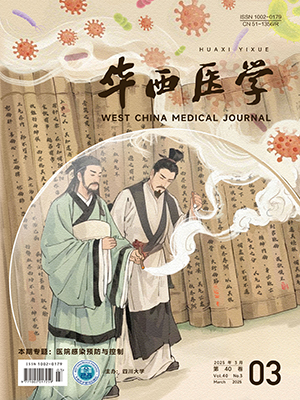【摘要】 目的 比较钻孔引流尿激酶溶解术和小骨窗开颅术治疗高血压脑出血的疗效。 方法 2008年9月-2009年12月分别接受钻孔引流尿激酶溶解术(A组,n=34)和小骨窗开颅术(B组,n=30)的高血压脑出血患者共64例(出血量30~50 mL,无脑疝),两组患者术前基线指标(如出血量、手术时机、昏迷程度等)比较无统计学意义。比较接受不同术式的两组患者手术时间、术后1个月的近期疗效、术后6个月远期疗效及死亡率。 结果 A组手术时间短于B组,两组比较,有统计学意义(P lt;0.05)。术后1、6个月,A组疗效优于B组,两组比较,有统计学意义(P lt;0.05)。A、B组术后近期和远期死亡率比较,无统计学意义(P gt;0.05)。 结论 对出血部位在基底节区、出血量在30~50 mL,无脑疝的高血压脑出血患者,钻孔引流尿激酶溶解术的疗效明显优于小骨窗开颅术。
【Abstract】 Objective To compare the therapeutic effect of drill drainage-urokinase perfusion (group A) and small bone flap craniotomy on hypertensive intracerebral hemorrhage. Methods A total of 64 patients with hypertensive intracerebral hemorrhage (about 30-50 mL) from September 2008 to December 2009 were collected. The patients underwent drill drainage-urokinase perfusion (group A,n=34) and small bone flap craniotomy (group B,n=30). The therapeutic effects, including operating time, short-term effect within one month, long-term effect six months after operation, operation time, and the rate of rehaemorrhagia and mortality were observed and the results of the two groups were compared. Results The operation time was shorter in group A than that in group B (P lt;0.05); one month and six months after the operation, the therapeutic effects were better in group A than those in group B (P lt;0.05); the difference in mortality between the two groups was not significant (P gt;0.05). Conclusion The therapeutic effect of drill draiage-urokinase perfusion is better than that of small bone flap craniotomy on the patients with hypertensive intracerebral hemorrhage in basal unclei with bleeding amount of 30-50 mL and without cerebralhern.
Citation: ZHU Chengming,YAO Wenhua,WANG Guifu,ZHANG Deming. Comparison between Skull Drill Drainage-urokinase Perfusion and Small Bone Flap Craniotomy for Removing the Hematoma in Hypertensive Cerebral Hemorrhage. West China Medical Journal, 2010, 25(11): 2035-2038. doi: Copy
Copyright © the editorial department of West China Medical Journal of West China Medical Publisher. All rights reserved




